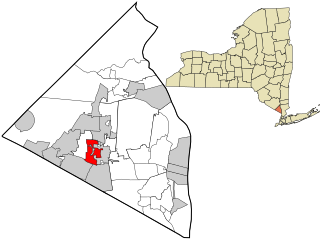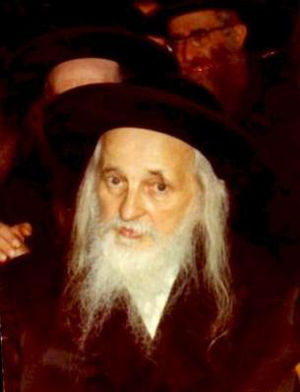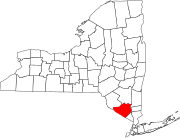
Kiryas Joel is a village coterminous with the Town of Palm Tree in Orange County, New York, United States. The village shares one government with the Town. The vast majority of its residents are Yiddish-speaking Hasidic Jews who belong to the worldwide Satmar sect of Hasidism.

Monsey is a hamlet and census-designated place in the town of Ramapo, Rockland County, New York, United States, located north of Airmont, east of Viola, south of New Hempstead, and west of Spring Valley. The village of Kaser is surrounded by the hamlet of Monsey. The 2020 census listed the population at 26,954; a 46% increase since the 2010 census.

New Square is an all-Hasidic village in the town of Ramapo, Rockland County, New York, United States. It is located north of Hillcrest, east of Viola, south of New Hempstead, and west of New City. As of the 2020 United States census, it had a population of 9,679. Its inhabitants are predominantly members of the Skverer Hasidic movement who seek to maintain a Hasidic lifestyle disconnected from the secular world. It is the poorest town in New York, and the eighth poorest in the United States. It also has the highest poverty rate, at 64.4%.

Joel Teitelbaum was the founder and first Grand Rebbe of the Satmar dynasty.

Satmar is a Hasidic group founded in 1905 by Grand Rebbe Joel Teitelbaum (1887–1979), in the city of Szatmárnémeti, Hungary. The group is an offshoot of the Sighet Hasidic dynasty. Following World War II, it was re-established in New York.

Chester is a town in Orange County, New York, United States. The population was 12,646 at the 2020 census. Chester contains a village, also called Chester.

Monroe is a village in Orange County, New York, United States. The population was 9,343 at the 2020 census. It is part of the Poughkeepsie–Newburgh–Middletown, NY Metropolitan Statistical Area as well as the larger New York–Newark–Bridgeport, NY-NJ-CT-PA Combined Statistical Area. The community is not named after President James Monroe, but rather after an early 19th-century New York state senator.

Kehillas Yaakov Pupa is a Hasidic dynasty, named after the Yiddish name of the town of its origin.

Moshe (Moses) Teitelbaum was a Hasidic rebbe and the world leader of the Satmar Hasidim.

Aaron Teitelbaum is one of the two Grand Rebbes of Satmar, and the chief rabbi of the Satmar community in Kiryas Joel, New York.

Yekusiel Yehuda Teitelbaum (III), known by the Yiddish colloquial name Zalman Leib (born 23 December 1951), is one of the two Grand Rebbes of Satmar. He leads the dynasty's Williamsburg, Brooklyn faction, which is based at the community's central Congregation Yetev Lev D'Satmar on Rodney Street there. He is the dean of a Satmar yeshiva in Queens, New York.
Board of Education of Kiryas Joel Village School District v. Grumet, 512 U.S. 687 (1994), was a case in which the United States Supreme Court ruled on the constitutionality of a school district created with boundaries that matched that of a religious community – in this case, the Satmar community of Kiryas Joel, New York. The case was argued by Nathan Lewin on behalf of Kiryas Joel, Julie Mereson on behalf of the State of New York, and Jay Worona on behalf of the respondents.
Teitelbaum is a Jewish surname. Variants include Tetelbaum, Teitelboim

Congregation Yetev Lev D'Satmar is a large Satmar Hasidic synagogue located at Kent Avenue and Hooper Street in Williamsburg, Brooklyn, New York City, New York, United States.
Siget or Ujhel-Siget or Sighet Hasidism, or Sigter Hasidim, is a movement of Hungarian Haredi Jews who adhere to Hasidism, and who are referred to as Sigeter Hasidim.

South Blooming Grove is a village inside the Town of Blooming Grove in Orange County, New York, United States. As of the 2020 census the population was 3,973. It is part of the Kiryas Joel–Poughkeepsie–Newburgh, NY Metropolitan Statistical Area as well as the larger New York–Newark–Bridgeport, NY-NJ-CT-PA Combined Statistical Area.
A coterminous municipality, sometimes also known as a coterminous city or a coterminous town-village, is a form of local government in some U.S. states in which a municipality and one or more civil townships have partial or complete consolidation of their government functions. A term used for the formation of such a local government is "township and municipal consolidation." This form of local government is distinct from a municipality coterminous with a higher level of government, which is called a consolidated city-county or a variation of that term.

Monroe is a town in Orange County, New York, United States. The population was 21,387 at the 2020 census, compared to 39,912 at the 2010 census; the significant fall in census population was due to the secession of the town of Palm Tree in 2019. The town is named after President James Monroe.

The Kiryas Joel murder conspiracy was the planned kidnapping and murder of Joseph Masri, a Hasidic resident of the village of Kiryas Joel, New York in a troubled marriage who had refused to give his wife a get. The plot was hatched during the summer of 2016 by Shimen Liebowitz, a divorce mediator from Kiryas Joel, Aharon Goldberg, an Israeli rabbi from Bnei Brak, and Binyamin Gottlieb. A fourth conspirator, operating under the pseudonym Joe Levin, turned out to be an informant for the Federal Bureau of Investigation, whose agents arrested the suspects in a sting operation before the crime could be committed. The trio were convicted and sentenced in 2017 to prison.
City of Joel is a 2018 documentary film exploring tensions in the town of Kiryas Joel, where over 20,000 Yiddish-speaking Satmar Hasidim live. Tensions center on the Hasidic residents' desire to annex the land adjacent to their community to allow for their community's future growth. In the film, the Hasidic stance toward the local opposition is one marked by suspicion of local anti-Semitism, insisting their case is one of constitutional rights to practice their religion. The documentary was directed by filmmaker Jesse Sweet.



















